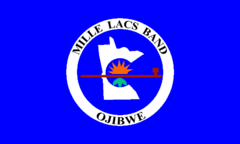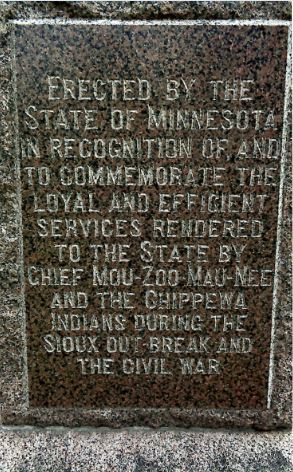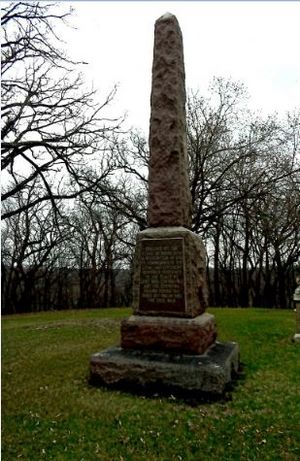Mille Lacs Band of Ojibwe facts for kids

tribal flag
|
|
| Total population | |
|---|---|
| 4,302 | |
| Regions with significant populations | |
| Languages | |
| English, Ojibwe | |
| Related ethnic groups | |
| White Earth Band, Leech Lake Band, Grand Portage Band, Bois Forte Band, Fond du Lac Band |
The Mille Lacs Band of Ojibwe (Ojibwe: Misi-zaaga'igani Anishinaabeg), also known as the Mille Lacs Band of Chippewa Indians, is a federally recognized American Indian tribe located in east-central Minnesota. The Band has 4,302 members as of 2012. Its homeland is the Mille Lacs Indian Reservation, consisting of District I (near Onamia), District II (near McGregor), District IIa (near Isle), and District III (near Hinckley).
The Mille Lacs Band is one of six members of the federally recognized Minnesota Chippewa Tribe, which they organized in 1934. The other members are the White Earth Band, Leech Lake Band, Grand Portage Band, Bois Forte Band, and Fond du Lac Band. "Chippewa," is a term commonly used in the United States to refer to Ojibwe people; the Mille Lacs Band prefers the term "Ojibwe," which is also more common in Canada.
Contents
Clans
There are eight major doodem (or clan) types found among the Mille Lacs Band of Ojibwe. They are Bizhiw (Lynx), Makwa (Bear), Waabizheshi (Marten) Awaazisii (Bullhead), Ma'iingan (Wolf), Migizi (Bald Eagle), Name (Sturgeon) and Moozens (Little Moose).
The historical Mille Lacs Band of Mdewakanton Dakota was part of the historical Mille Lacs Indians. The Snake River Band of Isanti Dakota became part of the historical St. Croix Band of Lake Superior Chippewa, which is today known as the St. Croix Chippewa Indians of Minnesota. Due to some of these Dakota ancestry, Mille Lacs Band of Ojibwe have a high degree of Ma'iingan-doodem members.
History

According to oral traditions, the Ojibwe, part of the Algonquian languages-speaking peoples, coalesced on the Atlantic coast of North America. About 500 years ago, the ancestors of the Mille Lacs Band of Ojibwe began migrating west. This tradition has been confirmed by linguistic and archeological evidence.
After driving previously settled Dakota villagers from the area in the mid-1700s, the Ojibwe had become established in the region around Mille Lacs Lake in what is today East Central Minnesota. They had a varied diet based on the resources of the area and hunted deer, bear, moose, waterfowl, and small game; fished the area's lakes and streams; gathered wild rice, maple sugar, nuts and berries; and cultivated some plants.
Europeans started arriving, among them French, British and American fur traders. Some European colonists stayed and began to compete with the Mille Lacs Band for resources and to encroach on their land. Such settlers continued to violate the treaties and agreements which the Mille Lacs Band made with the United States and British representatives over the decades.
The Ojibwe also suffered because of new infectious diseases, which killed many. By the end of the nineteenth century, only a few hundred Ojibwe remained on the Mille Lacs Indian Reservation. At that time, pressing for assimilation, the United States government prohibited the Ojibwe from practicing their religion (many had converted to Catholicism but still combined it with traditional prayers and rituals), tried to have their children sent to boarding schools at which they were forced to learn and speak English, and virtually denied their right to govern themselves. Their traditional way of life was nearly impossible to follow.
When the Sioux hostilities broke out in 1862 Chief Hole in the Day made threats to take the north to war too. Chief Mou-zoo-mau-nee of the Mille Lacs Band sent 300 warriors to the Fort Ripley to aid in its defense. In 1863 and 1864 the Mille Lacs Band signed two treaties that acknowledged their actions and made the tribe unremovable from their reservation as well as made the reservation boundaries permanent. The State erected a large monument to the Chief and the Mille Lacs band at Fort Ridgely cemetery in 1914 for their service to the State.
Over the next century, Ojibwe bands in the Mille Lacs region struggled with poverty and despair. With the passage of the 1934 Indian Reorganization Act, the bands of the Mille Lacs region joined five others in forming the Minnesota Chippewa Tribe, organized 1934-1936. The four historical bands in the Mille Lacs region (Mille Lacs Indians, Sandy Lake Band, Rice Lake Band of Mississippi Chippewa, and Snake and Kettle River Bands of St. Croix Chippewa Indians of Minnesota) were reorganized as the Mille Lacs Band of Ojibwe.
In the early 1990s, the Band opened Grand Casino Mille Lacs and Grand Casino Hinckley. Since then, casino revenues have allowed the Mille Lacs Band to strengthen its cultural identity, return to economic self-sufficiency, rebuild its reservation, and increase the prosperity of the entire region.
Tribal government
The Mille Lacs Band has a separation-of-powers form of government, making it one of the few Native American governments with three branches of government, similar to the government structure of the United States.
Executive branch
The current Chief Executive of the Mille Lacs Band of Ojibwe is Melanie Benjamin.
The Chief Executive, who is elected by Band members every four years, is the head of the executive branch. She appoints commissioners who are ratified by the Band Assembly to oversee the various departments in the executive branch.
- Department of Justice, headed by the Solicitor General
- Office of the Solicitor General
- Office of Public Safety
- Canine Registration
- Child Passenger Safety Seat Program
- Emergency Management
- Project Jumpstart
- Motor Vehicle Licensing
- Tribal Police Department
- Tribal Conservation Enforcement
- Band-member Legal Aid
- Administration Department, headed by the Commissioner of Administration
- Aanji-Bimaadizing
- Career Development and Training
- Adult and Youth Support Services
- Gotaamigozi Flex Labor
- Tribal Employment Rights Office (TERO)
- Veterans and Veteran families Services
- WiiDu Youth Activities
- Youth Career and Work Exploration
- Child Support Enforcement Program
- Facilities
- Neyaashiing Community Center
- [new] Community Center
- Chi-minising Community Center
- Minisinaakwaang Community Center
- Aazhoomog Community Center
- Meshakwad Community Center at Gaa-zhiigwanaabikokaag
- Urban Office
- Grants Management
- Human Resources
- Information Services
- Notary Services
- Self-Governance
- Aanji-Bimaadizing
- Department of Community Development, headed by the Commissioner of Community Development
- Facilities Maintenance
- Housing Department
- Housing Loans
- Housing Maintenance
- Resident Services
- Project Management
- Public Works Department
- Planning and Zoning
- Roads
- Sanitation
- Water and Sewer
- Corporate Commission, headed by the Commissioner of Corporate Affairs
- Corporate Ventures
- Maadaadizi Investments
- Philanthropy
- Adopt-a-School Program
- Donation
- Wewinabi, Inc.
- Corporate Ventures
- Department of Health and Human Services, headed by the Commissioner of Health and Human Services
- Ne-Ia-Shing Clinic
- District II Clinic Services
- Aazhoomog Clinic
- Public Health Department
- Behavioral Health Services
- Family Services
- Community Support Services
- Department of Natural Resources, headed by the Commissioner of Natural Resources
- Office of Natural Resource Management
- Agriculture
- Community Gardens
- Wildrice Management
- Land Management
- Resource Management
- Fisheries
- Forestry
- Licensing and Permitting
- Wildland Maintenance
- Agriculture
- Office of the Environment
- Air
- Brownfield
- Energy and Eco-systems
- General Environmental Assistance
- Water and Septic
- Office of Culture
- Cultural Resources
- Enrollments
- Tribal Historic Preservation Office
- Office of Natural Resource Management
- Department of Education, headed by the Commissioner of Education
- Nay Ah Shing School
- Nay Ah Shing Lower School (Abinoojiiyag)
- Nay Ah Shing Upper School
- Pine Grove Leadership Academy
- Minisinaakwaang Leadership Academy
- Wewinabi Early Education
- District I Cultural Immersion Program
- District II East Lake Education Program
- District III Aazhoomog Education Outreach Program
- Community Youth Services
- Higher Education
- Library
- Nay Ah Shing School
Legislative branch
The legislative branch of the Band’s government, known as the Band Assembly, consists of one Representative from each of the reservation’s three districts and a Secretary/Treasurer who presides over the Band Assembly as its Speaker. Each Representative is elected by the people of his or her district to serve a four-year term in the Band Assembly. Band members who live off the reservation select a home district and vote only for a Representative from that district. The Secretary/Treasurer is elected by all Band members.
The current Secretary/Treasurer of the Mille Lacs Band of Ojibwe is Sheldon Boyd, Speaker of the Band Assembly elected in April 2018.
- Band Assembly
- Legislative Administration
- Office of Budget and Management, headed by the Commissioner of Finance, appointed by Band Assembly
- Employee Payroll Services
- Insurance Services
- Revolving Loan Fund
- Burial Insurance
- Discretionary Loans
Judicial branch
The Chief Justice of the Mille Lacs Band of Ojibwe is Rayna Mattinas. The judicial branch includes the Chief Justice and the Court of Central Jurisdiction, which consists of three appellate justices and one district judge.
- Tribal Court
- District Court Liaison Services
Independent Agencies
- Department of Athletic Regulation
- Gaming Regulatory Authority (GRA)
- Office of Gaming Regulations & Compliance
- Charitable Gaming
- Compliance
- Internal Audit
- Licensing/Exclusions
- Surveillance
- Vendor Licensing
- Office of Gaming Regulations & Compliance
Corporate Ventures Holdings
- Gaming
- Grand Casino Hinckley, Hinckley, Minnesota
- Grand Casino Mille Lacs, Vineland, Minnesota
- Hospitality
- DoubleTree by Hilton Downtown Saint Paul, St. Paul, Minnesota
- DoubleTree by Hilton Minneapolis Park Place, St. Louis Park, Minnesota
- Embassy Suites Will Rogers Airport Hotel, Oklahoma City, Oklahoma
- InterContinental Saint Paul Riverfront, St. Paul, Minnesota
- Marketing & Technology
- Foxtrot Marketing Group
- Sweetgrass Media
- Maadaadizi Investments
- Makwa Global, LLC, Minneapolis, Minnesota (with offices in Onamia, Minnesota; Reston, Virginia; Hawaii; Germany; Nairobi, Kenya; and Dubai, UAE)
- Foxtrot Marketing Group
- Wewinabi, Inc. (Local Businesses)
- Big Sandy Lodge & Resort, Libby, Minnesota
- Crossroads Convenience Store, Lake Lena, Minnesota
- East Lake Convenience Store, East Lake, Minnesota
- Grand Makwa Cinema, Vineland, Minnesota
- Grand Market, Vineland, Minnesota
- Grindstone Laundry, Hinckley, Minnesota
- Hinckley Medical Office Building, Hinckley, Minnesota
- Lady Luck Estates, Hinckley, Minnesota
- Mille Lacs Super Stop, Onamia, Minnesota
- Taco John’s franchise at Mille Lacs Super Stop
- Mille Lacs Wastewater Management, Vineland, Minnesota
- Garrison, Kathio, West Mille Lacs Lake Sanitary District (in cooperation with City of Garrison, Minnesota and Kathio Township)
- Woodlands National Bank, Onamia, Minnesota (with branches in Cloquet, Minnesota; Hinckley, Minnesota; Minneapolis Minnesota; Sturgeon Lake, Minnesota, Vineland, Minnesota; and Zimmerman, Minnesota)
List of Mille Lacs Band of Ojibwe Chiefs
Chairman
- 1936–1940: Fred Sam
- 1940–1948: Sam Yankee
- 1948–1956: Fred Jones
- 1956–1960: Jerry Martin
- 1960–1972: Sam Yankee
- 1972–1991: Arthur Gahbow
- 1991–1992: Marge Anderson (interim appointment)
Chief Executive
- 1992–2000: Marge Anderson
- 2000–2008: Melanie Benjamin
- 2008–2009: Herbert Weyaus (interim appointment)
- 2009–2012: Marge Anderson
- 2012–present: Melanie Benjamin
Notable members
- Marge Anderson
- James Clark, Naawigiizis
- Lucy Clark
- Marvin Eagle
- Arthur Gahbow / Wewinabi ("Waywinabe")
- Virgil Hill, boxer
- Maude Kegg / Naawakamigookwe
- Larry Smallwood / Amikogaabaw
- Sam Yankee / Eshpan ("Ayshpun")


